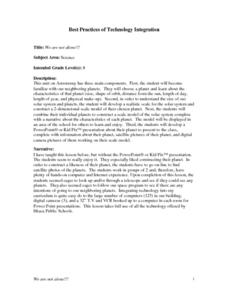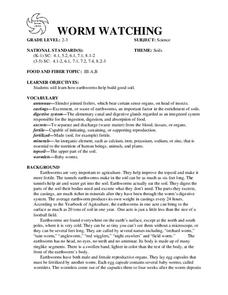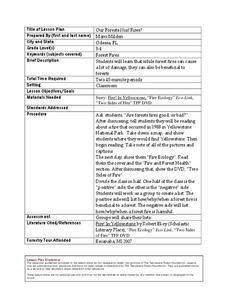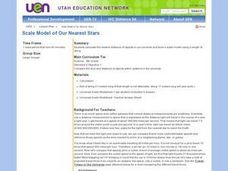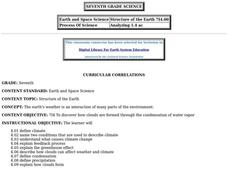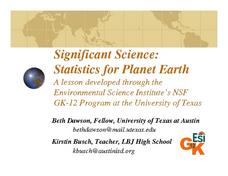Curated OER
Corals & Coral Reefs
Students describe a coral reef, how it is formed and its inhabitants. They explain the ecological and economic importance of coral reefs and discuss its present-day threats. Lesson contains adaptations for all levels.
Curated OER
We Are Not Alone!!!
Eighth graders explore the area of astronomy. They explore Earth's neighboring planets. Students research a planet's characteristics. They develop a scale model of the solar system and a narrative about the planets.
Curated OER
The Tiger, Panthera Tigris
Students explore tigers, India's national animal, discuss importance of protecting tigers and Earth's diverse ecosytems, investigate distribution of tigers in world, identify characteristics of tigers, examine natural habitat, and...
Curated OER
WORM WATCHING
Students investigate how earthworms help build good soil. They examine the worms carefully to find the ringlike segments and swollen band at the front of the earthworm's body. Students take turns dampening the soil every day and adding...
Curated OER
Echolocation
Young scholars explore echolocation. In this bats science lesson, students compare sunlight reflecting off a mirror to sound waves hitting a bat's ears. Young scholars complete a worksheet about bats.
Curated OER
Our Forests Need Fires?
Young scholars consider how forest fires are both damaging and beneficial to forests. In this earth science lesson, students are read the book Fire! In Yellowstone by Robert Ekey and watch "Fire Ecology" and "Two Sides of Fire" before...
Curated OER
Rain
First graders practice oral and silent reading using beginning comprehension and decoding strategies. In this guided reading lesson, 1st graders take a picture walk and make plot predictions prior to reading the book Rain by Robert...
Curated OER
Hot Air
Students conduct an experiment to determine how hot air affect the path of laser. In this physics lesson, students explain why stars appear to twinkle at night. They discuss how light travels from space to Earth.
Curated OER
Scale Model of Our Nearest Stars
Sixth graders calculate a light day, light hour, and light minute from the standard of a light year. After establishing the distances, a one meter scale is created to demonstrate the distance between the sun and the planets of our solar...
Curated OER
Water Conservation
Students explore types of water reserves. In this water conservation instructional activity, students brainstorm ways water are used in their homes. Students use a graduated cylinder to simulate the amount of water on Earth and the...
Curated OER
Interior of the Earth
Sixth graders identify and describe the composition and physical properties of the layers of the Earth. They also explain how scientists used the scientific process to know about the center of the Earth. Finally, 6th graders read a...
Curated OER
Science: Day and Night
Pupils listen to the Sky Tellers Native American story, "Ant Dances for Light," and illustrate it. They observe how Earth's rotation results in periods of darkness and light. Students investigate how day length varies throughout the...
Curated OER
Sun Shadow Cycles
High schoolers use diagrams to review how the Earth rotates around the sun. In groups, they use the same diagrams to explain how the sun shadows are produced and how they differ between seasons. They describe the Earth's rotation and...
Curated OER
Structure of the Earth
Eighth graders explain the difference between igneous, sedimentary and metamorphic rocks. They identify the stages in the rock cycle. They discover the origin of rocks as well.
Curated OER
Structure of the Earth
Seventh graders study the cause of climate change, and how clouds form and affect weather. They define condensation and precipitation, the greenhouse effect and the water cycle.
Curated OER
Earth and Space Science: Exploring Earthquakes
Students explore earthquakes. In this earthquake instructional activity, students research earthquakes and identify where they take place. Students use map skills to track down earthquake locations. There are internet sites suggested in...
Curated OER
The Earth's Rain Forests
Students study the importance of the world's rain forests. In this rain forest lesson, students read about the role of the rain forests in the world's environment. Students then write a formal letter to a member of Congress or Senate...
Curated OER
Beyond the Earth Part II
Students explore the solar system. In this solar system lesson, students use Internet and print resources to research a component of the solar system. Students create travel brochures based on their research findings.
Curated OER
Significant Science: Statistics for Planet Earth
Ninth graders discover how statistics are used to interpret results of scientific experiments. Students write hypotheses and test the hypotheses by collecting data and organizing the data. Students graph their data to produce a visual....
Curated OER
Earth Science: Create a Star Clock!
Students identify and use the starts to tell time just as people had for thousands of years. They identify the stars that appear to rise in the east and set in the west, and that those stars near the North Pole appear to go in circles...
Curated OER
The Day an Egg Solved the Mystery of the Cell
Students conduct an experiment comparing human cells to chicken cells. In this cells lesson plan, students conduct an experiment to see how nutrition moves through cells and how to better take care of their bodies.
Curated OER
Learn to Build a Rocket in 5 Days or Your Money Back
Students discover the entire process that goes into designing a rocket for any customer. They study important factors such as supplies, ethics, deadlines and budgets. Also, students explore about the Engineering process, and recognize...
Curated OER
The Big Burp:A Bad Day in the Paleocene
Students describe the overall events that occurred during the Paleocene extinction event as well as the processes that are believed to result in global warming after group research. They infer how a global warming event could have...
Curated OER
The Science of Glaciers
Students identify the contents of a glacier like those found in Patagonia. They construct a mini glacier model in class. Students compare and contrast the classroom model with Patagonian glaciers. They label specific parts of the...
Other popular searches
- Science Earth Day Activities
- Science Earth Day Lessons
- Earth Day Science
- Earth Day Science Projects
- Earth Day Science Lesson Plans
- Earth Science Earth Day



